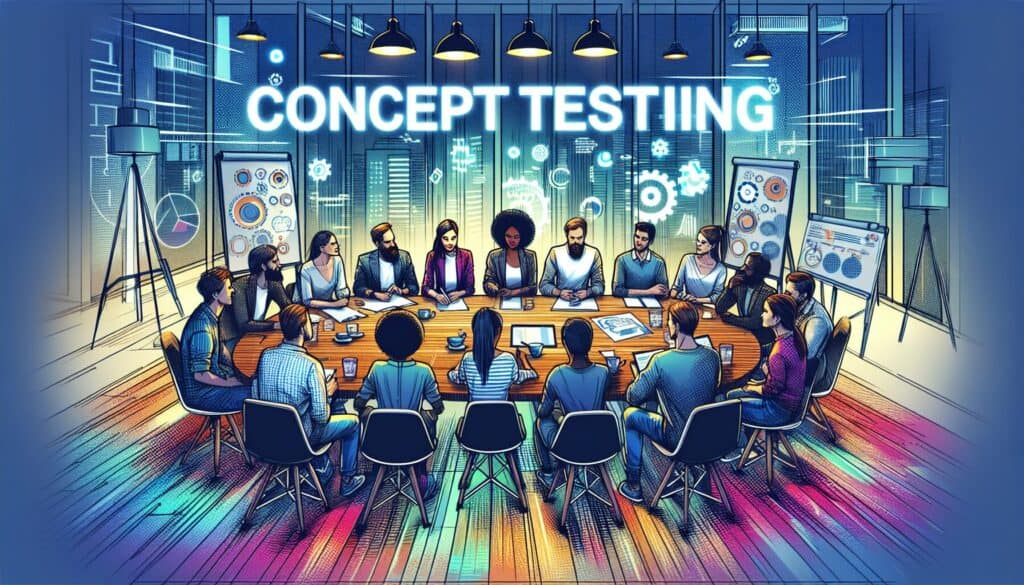To obtain early feedback on product or service ideas from the target audience before significant development investment.
- المنهجيات: الهندسة, تصميم المنتج, إدارة المشاريع
Concept Testing

Concept Testing
- المنهجية الرشيقة, تجربة العملاء, التفكير التصميمي, أبحاث السوق, تطوير المنتجات, Product Management, النماذج الأولية, User Testing, التحقق من الصحة
الهدف:
كيفية استخدامه:
- Presenting a description of a new product or service concept (e.g., written description, mock-up, storyboard) to potential customers and gathering their reactions, preferences, and purchase intent.
الإيجابيات
- Helps filter out poor concepts early; provides insights for refining promising concepts; reduces risk of market failure.
السلبيات
- Reactions to concepts may not accurately predict actual market behavior; feedback quality depends on how well the concept is communicated.
الفئات:
- العملاء والتسويق, تصميم المنتج
الأفضل لـ
- Gauging customer interest and gathering feedback on new product or service ideas before development.
Concept Testing serves as a pivotal stage in the product development process, especially within industries such as consumer electronics, automotive, food and beverage, and healthcare, where understanding consumer preferences is vital. This methodology typically takes place during the early phases of product design, often after an idea has been generated but before significant resources are committed to development. Participants in this process might include product managers, marketing teams, designers, and potential users who can provide diverse perspectives. The presentation of concepts might involve various formats such as detailed descriptions, prototypes, or interactive storyboards, aimed at capturing customer reactions in realistic contexts. Insights gathered can inform decisions related to product features, design aesthetics, and pricing strategies, enhancing alignment with market demands. For example, in the tech sector, companies may use concept testing to evaluate new gadget designs or software functionalities before iterations are launched into development. By validating preliminary ideas and refining them based on consumer feedback, organizations can significantly reduce the likelihood of launching products that fail to meet market needs, thereby conserving resources and ensuring a more streamlined path to successful product releases.
الخطوات الرئيسية لهذه المنهجية
- Define the concept to be tested, including key features and benefits.
- Select appropriate customer segments for targeted feedback.
- Create a tangible representation of the concept, such as a prototype or storyboard.
- Conduct one-on-one interviews or focus groups to present the concept.
- Ask specific questions about the concept’s appeal, usability, and value.
- Gauge customer purchase intent through direct and indirect inquiries.
- Analyze feedback to identify trends, preferences, and areas for improvement.
- Iterate on the concept based on the reactions and suggestions received.
نصائح للمحترفين
- Utilize cognitive interviewing techniques during concept testing to explore underlying motivations and reactions, leading to deeper understanding of customer preferences.
- Incorporate quantitative methods alongside qualitative feedback, such as conjoint analysis, to assess purchase intent and prioritize features with the highest value to target demographics.
- Implement iterative testing, where concepts are revised based on feedback before re-testing, allowing for continuous refinement and a more targeted final product.
لقراءة عدة منهجيات ومقارنتها, نوصي باستخدام
> مستودع المنهجيات الشامل <
مع أكثر من 400 منهجية أخرى.
نرحب بتعليقاتكم على هذه المنهجية أو المعلومات الإضافية على قسم التعليقات أدناه ↓، وكذلك أي أفكار أو روابط متعلقة بالهندسة.
منشورات ذات صلة
استبيانات الانزعاج العضلي الهيكلي
الاختبار متعدد المتغيرات (MVT)
تحليل الانحدار المتعدد
أنظمة التقاط الحركة
طريقة MoSCoW
اختبار متوسط المزاج